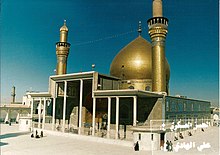ʿAlī al-Hādī an-Naqī
ʿAlī al-Hādī an-Naqī ( Arabic علي الهادي النقي* September 8, 828 in Medina ; † July 1, 868 in Samarra ) was the tenth Imam according to the belief of the Twelve Shiites and thus a direct descendant of the Prophet Mohammed .
Life
ĪAlī al-Hādī lived under arrest in his home in Samarra for most of his life . As his successor he had initially designated his eldest son Abū Jafar Muhammad. But since he died during his lifetime, he appointed his second oldest son Hasan as his successor. This transfer of the succession from Muhammad to Hasan, which made some followers of ʿAlī al-Hādī doubt him, was subsequently legitimized with a change of will ( badāʾ ) of God.
ʿAlī al-Hādī died on July 1, 868 (3rd Rajab 254 AH ) He was probably poisoned, the Shiite sources name the Abbasid caliph al-Mutazz as the instigator. His son Hasan succeeded him as imam.
His grave
Ali an-Naqi was buried in the Al-Askari shrine in Samarra, which is named after his son Hasan al-Askari, who was also buried there . This shrine is considered sacred by the Shiites . The shrine of the two imams was badly damaged by a terrorist attack on February 22nd, 2006 .
literature
- Hossein Modarressi: Crisis and Consolidation in the formative period of Shiʿite Islam. Abū Jaʿfar ibn Qiba al-Rāzī and his contribution to Imāmite Shīʿite thought. Darwin Press, Princeton, New Jersey, 1993. pp. 215-218.
Web links
Individual evidence
- ↑ See Modarressi: Crisis and Consolidation . 1993, p. 65.
- ↑ See Modarressi: Crisis and Consolidation . 1993, pp. 43, 215f.
| personal data | |
|---|---|
| SURNAME | ʿAlī al-Hādī an-Naqī |
| ALTERNATIVE NAMES | ʿAlī al-Hādī, ʿAlī an-Naqī |
| BRIEF DESCRIPTION | tenth Imam according to the belief of the Twelve Shiites (Imamites) |
| DATE OF BIRTH | September 8, 828 |
| PLACE OF BIRTH | Medina |
| DATE OF DEATH | July 1, 868 |
| Place of death | Samarra |

